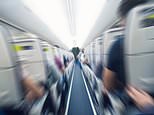
Fasten your seat belt — because we’re in for some bumpy flights. Rising temperatures and changes to the jet stream have dramatically increased the amount of turbulence in the sky, according to research from the University of Reading.
Severe turbulence increased 55 per cent between 1979 and 2020 and is expected to get more intense, more frequent and last longer in future.
That’s the bad news, But, fortunately, pilots and cabin crew say we’re safer than we think — however turbulent life gets at 35,000 feet.
‘Modern aircraft are incredibly strong and pilots are trained and ready for turbulence,’ says British Airways captain Steve Allright, who runs the airline’s Flying with Confidence course for nervous passengers. He says most turbulence is triggered by changes in the speed or direction of winds around a plane, and is a bit like a car driving over bumps in the road. ‘It can be uncomfortable but it’s totally safe.’
Virgin Atlantic cabin crew member Jennie Jordan says that although passengers can be terrified by turbulence she’s never seen anyone injured by it in nearly two decades of flying.
Severe turbulence increased 55 per cent between 1979 and 2020 and is expected to get more intense, more frequent and last longer in future
‘The big thing is to buckle up and stay seated when the “fasten seat belt” signs go on mid-flight,’ she says. ‘Other crew have had passengers stumble and fall in the aisle during a bumpy patch. Anything more serious is incredibly rare.’
WHEN DOES TURBULENCE HIT?
Pilots say there are two main types of turbulence. The first is triggered by high winds near the ground and storms in low-level clouds, so it tends to hit in the first and last 30 minutes of a flight.
The second is ‘clear air’ turbulence above the clouds, when high-level winds change pace without warning. While it can happen at any time it’s most common over mountain ranges and oceans such as the Atlantic and Pacific.
WORST ROUTES
The skies over the Atlantic are getting wilder as the jet stream moves, probably due to climate change. So key holiday routes to America, Canada and the Caribbean could become bumpier.
In Europe, flights going over the Alps can be rocky with routes to Switzerland and Austria seeing the most turbulence.
Long-haul routes including London to Johannesburg and Durban can be bumpy, while the skies over Japan are notoriously lumpy. Fly to Australia and you may be turbulence-free all the way Down Under — but expect to hit bumps on the last legs to Sydney, Brisbane or Melbourne.
SMOOTHEST ROUTES
It’s rare for short-haul flights to Europe to suffer more than a short stretch of light turbulence. Meteorologists inform pilots in advance of bad weather, allowing planes to re-route and avoid the worst.
Passengers can get their own predictions on websites such as turbli.com. It scans the skies up to 36 hours ahead of flights, looks for thunderstorm forecasts, predicts whether take-offs and landings will be smooth and if turbulence will be light, moderate or strong.
TRICKY AIRPORTS
The skies over the Atlantic are getting wilder as the jet stream moves, probably due to climate change
Pilots say landing anywhere near the equator can be tricky, as wind speeds change fast and storms break suddenly.
Holiday airports including Miami, Orlando and Cancun can be bumpy along with Bangkok, Hong Kong and Singapore. Strong winds mean Madeira airport is tricky for pilots, with planes often diverting to nearby Porto Santo island until the weather improves.
Gibraltar airport can get pulses racing (the sea looms at each end of the runway and pilots have to slam on the brakes fast) while high winds can rock planes near the Canary Islands.
The final approach to Athens airport is also notorious for bumpy skies.
BEST PLACE TO SIT
Frequent fliers say seats near the centre of a plane promise the smoothest flight and those at the back are bumpiest. But experts say the difference is so slight it won’t be noticed, especially on big planes like Boeing’s Dreamliner or the double-decker Airbus A380.
Some say window seats (and even the dreaded middle seat) could be safer on bumpy flights. That’s because items in the overhead lockers can move during flight and fall out causing injury — often to those in aisle seats below. Cabin crew say metal water bottles falling from lockers are one of the biggest causes of in-flight accidents.
Mid-air thunderstorms can be terrifying, especially if lightning flashes outside cabin windows. But planes are designed to brush off storms.If struck, electricity passes through the aircraft’s exterior without affecting the interior. Most planes are struck at least once a year with no ill effects
BEST TIME TO FLY
Turbulence can strike at any time but weather experts say night-time and early morning flights can be the smoothest.
Meteorologists say changes in air temperature are less extreme after the sun has gone down, and thunderstorms tend to break at the end, rather than the start, of the day.
AVOIDING TURBULENCE
Pilots try to dodge it. Pre-departure weather forecasts and mid-flight updates show where stormy skies lie with routes and altitudes chosen accordingly. Planes further ahead on the same route pass tips back to air traffic control for those following.
The amount of time flying through bumps can also be cut as turbulence tends to occur in long, shallow layers of air as little as 100m deep. Moving above or below the layers can put planes back in smoother air.
AIR POCKETS A DANGER?
No, because they don’t really exist. The term was coined to describe the feeling of planes lurching down suddenly during a turbulent flight. In reality, pilots say there are no ‘pockets’ of air to fall through and, however dramatic the jolts may feel, planes rarely lose more than a few meters of altitude in turbulent skies.
LIGHTNING STRIKE FEARS
Mid-air thunderstorms can be terrifying, especially if lightning flashes outside cabin windows. But planes are designed to brush off storms.
If struck, electricity passes through the aircraft’s exterior without affecting the interior. Most planes are struck at least once a year with no ill effects.
The only time thunderstorms cause big problems is when they cluster round airports. That’s when air traffic control can limit landings and take-offs, triggering delays and cancellations.
CABIN CREW CODE
When the seat belt signs go on mid-flight, cabin crew should break off from other duties to check everyone is strapped in. That includes waking sleeping passengers if crew can’t see their belts and checking babies are out of cots and strapped to parents.
If the ‘fasten seat belt’ signs stay on for a long time crew can continue serving meals, though they shouldn’t pour hot drinks.
But if you hear the announcement, ‘Cabin crew, take your seats’ in the middle of a flight then flight attendants must strap in as well. It’s rare, but means a bad patch lies ahead.
Source link
CHECK OUT: Top Travel Destinations
READ MORE: Travel News



